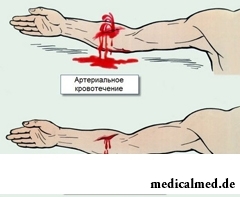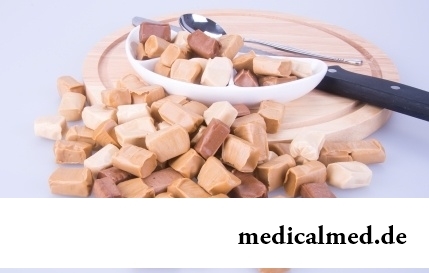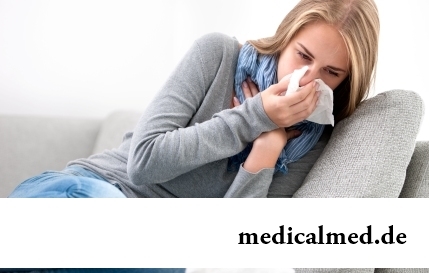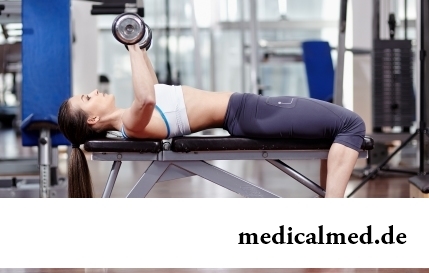





Bleeding
Bleedings - the most dangerous posttraumatic complications, life-threatening the injured person. Degree of possible risk depends on specific characteristics and the location of the damaged vessels.
Types of bleedings
 There is the following classification of types of bleedings:
There is the following classification of types of bleedings:
- Capillary bleeding. This type of bleeding meets when traumatizing the smallest vessels located in mucous membranes, muscular tissue, integuments. Symptoms of bleeding from capillaries is: dark red color of blood, istekany blood a small stream (at superficial cuts) or uniform release of blood on all surface of a wound (at grazes). Capillary bleeding extremely seldom threatens life and health of the injured person (if there is no disease of hemophilia and problems with coagulability of blood) and, as a rule, stops independently.
- Venous bleeding. To the main symptoms of bleeding from veins the slow, but continuous istekaniye of blood from a wound is. Blood has dark red color. At venous bleeding of significant force for prevention of loss of a large amount of blood it is necessary to press urgently damaged vessel by means of any make-shift (it is possible even by means of a finger).
- Parenchymatous bleeding. Treats internal bleedings. It is characteristic at wounds and slight injuries, a liver, a spleen and other internals. At this look perhaps istekany blood of various color (depending on what internal body is damaged) – dark red and bright red color. At a blood exit outside, she acts evenly on all wound surface. The greatest danger is constituted by option when parenchymatous bleeding proceeds is hidden. The patient risks to lose a lot of blood, without having waited for first-aid treatment since diagnosis of internal bleeding is extremely complicated.
- Arterial bleeding. A characteristic symptom of bleeding from arteries is the pulsing jet expiration of blood from a wound, color of blood has a bright red shade. This look poses special hazard to life of the victim since promptly leads to approach of full desalination of an organism. Development of acute anemia at arterial bleeding is followed by the following, the most explicit, signs: falling of pulse and arterial pressure, the progressing pallor of integuments and mucous membranes, nausea, vomiting, blackout, dizziness, a loss of consciousness.
- The mixed (combined) bleeding – arises at extensive injuries and combines the different types of bleedings described in the previous points.
Treatment of bleedings
Actions for first-aid treatment at bleeding have to be begun as it is possible in shorter terms after traumatizing. They consist first of all in a stop of bleeding and the prevention of considerable losses of blood. If it is about arterial bleeding, necessary measures for a stop of bleeding need to be taken immediately since at this type of bleedings for a short span the considerable volume of blood follows from wound damage. The Bystry and sharp loss of blood (more than two liters) can lead the victim to a lethal outcome, especially if bleeding is combined with the combined traumatic damages.
For obvious reasons, first aid at bleeding is, as a rule, made out of walls of medical institution. Therefore this procedure is temporary, and consists in a bleeding stop for the fastest transportation of the injured person in conditions of a medical hospital.
Ways of a temporary stop of bleeding:
 Compressing bandage. Use for pressing of the direct place of bleeding. Apply a sterile gauze bandage a wound surface (at absence – a piece of any pure natural fabric) and densely bandage (in the absence of material for bandaging, just press a bandage to a wound a hand). Apply at the capillary, venous and mixed bleedings of moderate intensity.
Compressing bandage. Use for pressing of the direct place of bleeding. Apply a sterile gauze bandage a wound surface (at absence – a piece of any pure natural fabric) and densely bandage (in the absence of material for bandaging, just press a bandage to a wound a hand). Apply at the capillary, venous and mixed bleedings of moderate intensity.- At insignificant bleedings at wound damages by a foot, shins, fingers, etc. use a way of giving to the injured extremity of the raised situation. It is good to combine this way with imposing of a compressing bandage.
- In case of arterial bleeding and need of an immediate stop of bleeding (when there is no time for searches of suitable means) use a way of pressing of the bleeding artery a finger. Arteries press in certain anatomic points where they can be pressed densely to bones and by that temporarily to stop bleeding.
In operating time our brain spends the amount of energy equal to the 10 Watts bulb. So the image of a bulb over the head at the time of emergence of an interesting thought is not so far from the truth.

What woman does not dream of a beautiful and thick hair? So far physicians developed difficult schemes on hair transplant, in the bet industry...
Section: Articles about health
Smoking not only exerts a negative impact on the state of health of the consumer of tobacco products, but is an air polluter the substances potentially dangerous to people around. In recent years significantly the number of people, стремящ increased...
Section: Articles about health
Practically each person is familiar with the annoying, pulling, unscrewing pains caused by overcooling of muscles of a back. In certain cases inflammatory process is not limited to discomfort, being followed by emergence of hypostasis, consolidations, temperature increase. At the wrong treatment the acute miositis can lead to a chronic disease or aggravation of other pathologies of a back (vertebral hernia, osteochondrosis) therefore it is important to pay attention to symptoms of an illness in time and to start to...
Section: Articles about health
What they, women? Beautiful, gentle, passionate and at the same time windy, gusty, and nervous. And what is stranger: all эт...
Section: Articles about health
Food with the increased content of sugar is attractive to most of people - it is scientifically confirmed fact. Business here not in intemperance or dissoluteness: the sweet food is associated since childhood with feeling of rest and safety which is felt by the kid, to...
Section: Articles about health
Cold is such painful that each sigh becomes a victory, heat "knocks" down, and the ache in joints forces to think only of pain. Some people with approach of the first symptoms of cold make the self-sacrificing decision to have a disease standing, and at best to rest in bed with a cup of hot tea. There is an opinion that if not to treat cold, then the organism itself, sooner or later, will overcome an illness. Whether so it? It is known that if in time it is simple not to begin treatment, apparently, harmless...
Section: Articles about health
Quite large number of people adheres to the principles of vegetarian food. But how to be if in a family of vegetarians is д...
Section: Articles about health
What will only not be thought up by persons interested to have a beautiful figure. Here the last innovation – for weight loss needs to be eaten greasy food. Let's understand whether there is at a fatty diet common sense....
Section: Slideshow
During foot walks blood moves on vessels more actively and one and all bodies are supplied with a large amount of oxygen. It affects the state of health of the person very positively....
Section: Slideshow
The business lady, the become mother, it is necessary to solve an array of problems. But of them is main: how to combine the beloved child and work?...
Section: Slideshow
The fatigue, sleep debt, disturbances of food, bad mood, vagaries of the weather – all these circumstances badly affect our appearance. Especially the person suffers: skin becomes flabby, loses healthy color, becomes covered by wrinkles, zones of hypostases and t appear...
Section: Articles about health
Traveling all over the world, many try to try the most exotic dishes of national cuisines. There is even a so-called gastronomic tourism which, according to gourmets, not only allows to receive new feelings, but also is capable to show life of other people from absolutely unexpected side....
Section: Articles about health
Statistically cystitis 25-30% of women up to 40 years have. With age this indicator raises, besides many do not get in to become...
Section: Articles about health
Good appetite was always considered as a sign of good health. The correct operation of the mechanism which is responsible for the need for nutrients and receiving pleasure from process of its satisfaction demonstrates that the organism functions without special from...
Section: Articles about health
One of the useful properties presented to the person by the nature is ability to feel fear. This ability is designed to signal about approach of a dangerous situation and to help to avoid in advance it to keep life. However if the fear is persuasive and is not reasonable, it can seriously limit possibilities of the person in respect of socialization and self-realization. Such pathological fear is called a phobia....
Section: Articles about health
The advantage of swimming for the person is so high that this sport is not only the most popular, but also is widely applied in copper...
Section: Slideshow
Sometimes it seems that modern society was divided into two camps: representatives of the first are sure that only the woman has to be responsible for contraception, representatives of the second, respectively, are sure that it is destiny of men. Meanwhile Dov has a question of contraception...
Section: Articles about health
High temperature - a frequent symptom of such widespread diseases as a SARS, quinsy, pneumonia, etc. To reduce heat, having facilitated a condition of the patient, doctors recommend to accept antipyretics, however their use is not always possible. Too frequent use of these drugs can lead to allergic reactions, and also overdose, causing poisoning. It happens also that there are no antipyretics simply in the house. In these situations it is pertinent to use it...
Section: Articles about health
In consciousness of our many compatriots idea that folk remedies if no more эфф strongly took roots...
Section: Articles about health
According to data of World Health Organization, the cataract is diagnosed almost for 7% of the population of Earth. The statistics of incidence is considered not full as at an initial stage the illness, as a rule, does not cause to the person of special inconveniences, and many having got sick...
Section: Articles about health
The pancreas performs two functions in a human body: release of enzymes without which digestion of carbohydrates, fats and proteins, and a producing hormones is impossible. The most important of them - insulin, is the main participant of carbohydrate metabolism normalizing processes of education and utilization of glucose, the main energy source for an organism....
Section: Articles about health
(Xerostomia) many people consider feeling of a xerostomia small and easily removable inconvenience. This delusion...
Section: Articles about health
Each person knows that fervescence is an illness sign. However too low temperature (hypothermia), especially also can demonstrate existence of diseases when it is observed long enough. Such state is dangerous those...
Section: Articles about health
All of us, unfortunately, should face flu nearly an every year. It would seem, so frequent disease has to be studied already up and down, and each person, at least once to them had (and the number of such people in our country aims at 100%), has to know the basic rules of its treatment. However as shows experience of doctors, there is no it, and often people, self-confidently thinking what is known as it is necessary to be treated, make mistakes....
Section: Articles about health
Is told about advantage of domestic animals for development of the child much. But many parents nevertheless do not hurry to bring pets as about...
Section: Articles about health
For many spouses the question of planning of a family is one of the main. The problem of the choice of effective and safe contraceptives at the same time comes out on top. Russians still not often resort to operation of a vasectomy extremely popular in the USA...
Section: Articles about health
Women quite often suffer from complexes concerning the sizes of the bust. Strangely enough, not too modest, and excessively curvy shapes become the reason of sincere discomfort sometimes. Except psychological problems, the big bust sometimes creates also quite notable malfunctions with health: his owner can feel muscular dorsodynias, feeling of constant fatigue and difficulty of breath. Over time excess loading leads to development of diseases позвоночн...
Section: Articles about health
